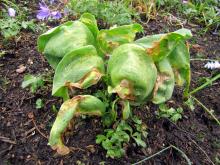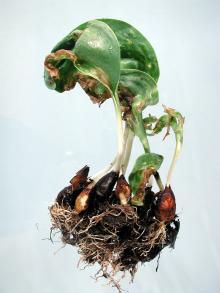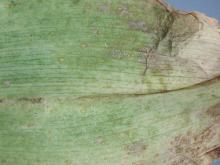Cause Botrytis tulipae, a fungus that overwinters as sclerotia in soil, affected bulbs, and diseased plant residue. Germination of sclerotia and infection of emerging shoots is greatest when soil is 41°F. Flowers are very susceptible to this fungus. Flower petals that drop onto leaves can promote further development on the leaves, especially in the leaf axils and on stems. High humidity, rainfall, and moderate temperatures favor the blight phase of this disease. Sclerotia can develop at the base of stems and on the outer scales of the developing daughter bulbs. Loss of leaves results in a severe reduction in bulb yields. Host range is limited to tulip.
Symptoms Emerging shoots that become infected prior to emergence are called "fireheads". Spores produced on fireheads or sclerotia near the surface of the soil can spread to nearby foliage which develop small, somewhat elongated spots that often look yellow and water soaked. As spots enlarge, leaves may distort and partially rot, particularly at the base. As the disease advances, infected areas turn whitish gray. Numerous leaves are distorted or partially collapsed. The fungus attacks flowers and flower stems the same way. The whitish gray, powdery spore coating on the flowers is very noticeable. At the stem's base and on the bulb's outer scales may be many blackish or dark brown sclerotia, which carry the fungus from one growing season to the next or other unfavorable conditions.
Cultural control Focus on integrating several cultural tactics.
- At fall planting time, examine all bulbs; discard diseased ones.
- Rotate tulips to new location each year to prevent fungal sclerotia buildup in soil.
- Plant using healthy stock.
- Space plants for good air circulation.
- Avoid high rates of nitrogen.
- Remove diseased fireheads as they emerge from the soil. Continue to remove diseased plants and adjacent soil as soon as you notice the disease. Also, remove flowers before petal fall.
- Annual digging during dry weather.
Chemical control Integrate chemical tactics with cultural controls. Alternate or tank-mix fungicides with different modes of activity to prevent or delay the buildup of resistant fungi. Limit the use of any one group during crop production.
- Astun at 10 to 17 fl oz/100 gal water. Group 7 fungicide. 12-hr reentry.
- Broadform at 4 to 8 fl oz/100 gal water. Group 7 + 11 fungicide. 12-hr reentry.
- Daconil Weather Stik at 1.38 pints/100 gal water. May leave a high amount of visible residue on leaves. Group M5 fungicide. 12-hr reentry.
- Decree 50 WDG at 0.75 to 1.5 lb/100 gal water. Group 17 fungicide. 12-hr reentry.
- Fore (80% mancozeb) at 1.5 lb/100 gal water. Group M3 fungicide. 24-hr reentry.
- Insignia SC at 6 to 12 fl oz/100 gal water. Do not use with organosilicate-based adjuvants. Use preventively only. Group 11 fungicide. 12-hr reentry.
- Medallion WDG at 2 to 4 oz/100 gal water. Use with oils or adjuvants may cause plant damage. Group 12 fungicide. 12-hr reentry.
- Orkestra at 8 fl oz/100 gal water. Group 7 + 11 fungicide. 12-hr reentry.
- Pageant at 12 to 18 oz/100 gal water. Do not use with organosilicone-based adjuvants. Group 7 + 11 fungicide. 12-hr reentry.
- Palladium at 4 to 6 oz/100 gal water. Avoid excessive runoff to small plants, which may result in stunting and/or chlorosis. Group 9 + 12 fungicide. 12-hr reentry.
- Spectro 90 WDG at 1 to 2 lb/100 gal water. Group 1 + M5 fungicide. 12-hr reentry.
- Spirato GHN at 2 to 4 fl oz/100 gal water. Use with oils or adjuvants may cause plant damage. Group 12 fungicide. 12-hr reentry.
- Thiophanate-methyl-based products tank-mixed with another product. Group 1 fungicides. 12-hr reentry.
- Cleary's 3336 EG at 12 to 16 oz/100 gal water.
- OHP 6672 4.5 F at 10 to 14.5 fl oz/100 gal water.
Biological control
- LALStop G46 WG (Clonostachys rosea [formerly Gliocladium catenulatum] strain J1446) at 0.13 oz/1 gal water. Do not use with other products in the tank. 4-hr reentry. O
Reference Coley-Smith, J.R. and Javed, Z.U.R. 1972. Germination of sclerotia of Botrytis tulipae, the cause of tulip fire. Annals of Applied Biology 71:99-109.




